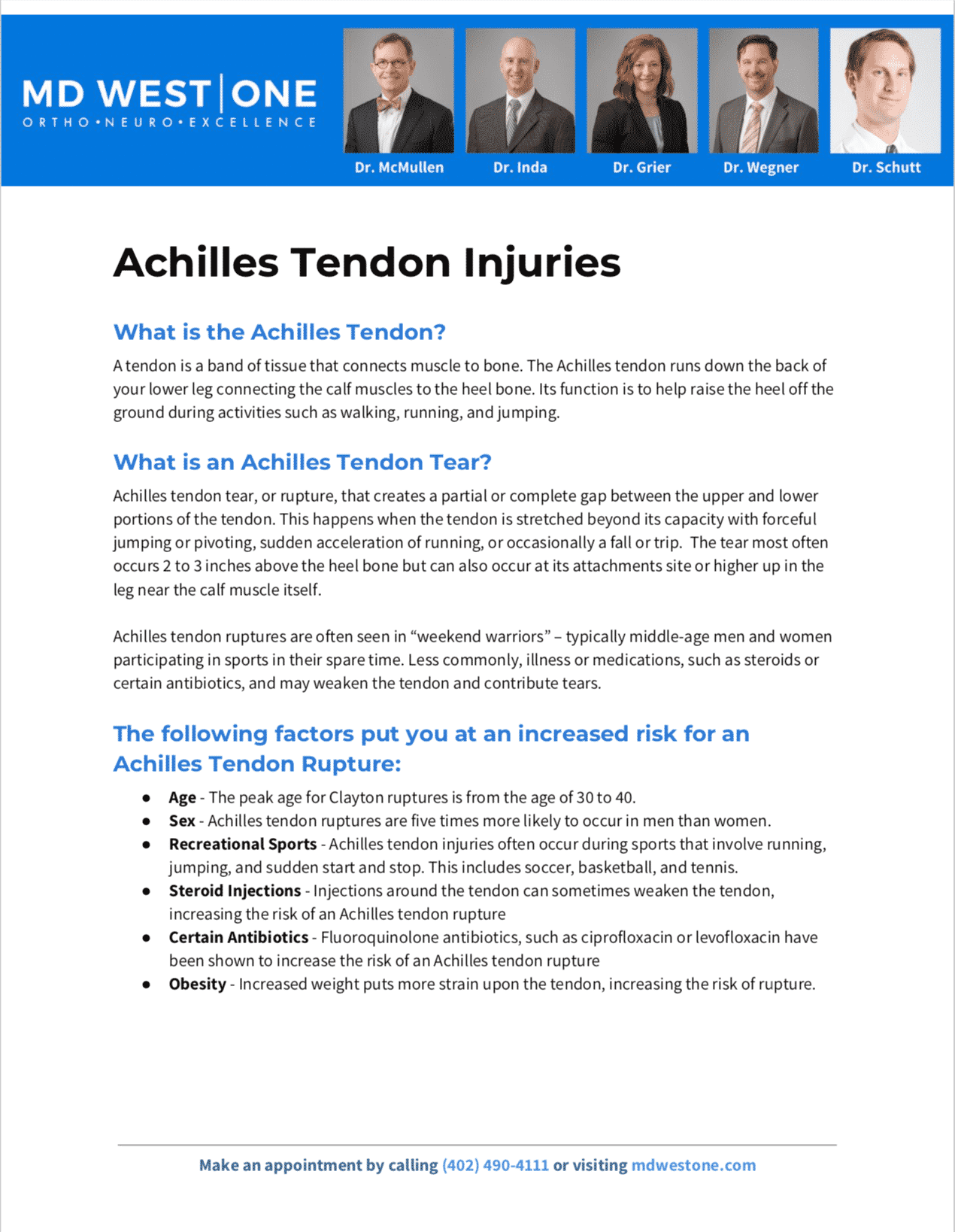Are you suffering from potential Stiff Big Toe?
The Omaha Foot & Ankle Specialists at MD West ONE are able to properly diagnose and treat Stiff Big Toe through both surgical and non-surgical treatments. If you have the following symptoms, you may want to make an appointment with one of our Board Certified Specialists.
- Your toe’s motion decreases over time so that walking or even standing is painful
- Pain and stiffness worsen in cold, damp weather
- Your toe joint becomes swollen and inflamed
- A bump, like a bunion or callus, develops on the top of the foot. Wearing shoes might be uncomfortable
Meet MD West ONE's foot and ankle specialists and learn more about how they treat Stiff Big Toe.
Stiff Big Toe Causes, Treatments & Surgery
What is Stiff Big Toe?
Hallux rigidus means "stiff big toe" - the main symptom of the disorder. Hallux rigidus is a type of degenerative arthritis, a common type of arthritis. It is sometimes called "big toe arthritis."
The following factor put you at an increased risk for Stiff Big Toe:
-
Age - It is most common in people between the ages of 30 and 60.
Ways to Decrease Your Risk of Developing Stiff Big Toe:
You cannot keep the condition from happening, but you can slow its progress if you:
- Exercise to keep the joint mobile.
- Rest the joint when you feel pain.
- Wear good-fitting shoes with enough space around the toes.
DIAGNOSIS
Your healthcare provider can diagnose Stiff Big Toe or Hallux Rigidus by testing your toe joint's range of motion. Your provider may check how far you can bend the toe up and down. An X-ray can show any bone abnormalities or bone spur development.
NON-SURGICAL TREATMENT OPTIONS
To relieve pain, your healthcare provider may recommend:
- Appropriate shoes: Wear shoes that have plenty of room for your toes. You may find that shoes with stiff soles relieve pain. Avoid wearing high heels.
- Limited toe movement: Place pads in your shoe to limit movement of your big toe. Avoid activities that stress your toe joint, such as jogging.
- Pain relievers: Nonsteroidal anti-inflammatory medications, such as ibuprofen, can relieve pain, and reduce swelling.
- Foot soaks: Try a contrast bath, switching between hot and cold water to relieve inflammation. Place your foot in hot water for 30 seconds, then right away in cold water for 30 seconds.
- Injections: Corticosteroid injections can help relieve pain.
SURGICAL TREATMENT OPTIONS
Sometimes, conservative measures are not enough. You may still have pain and stiffness. If the pain interferes with your life, surgery can help. Surgical procedures for hallux rigidus include:
- Cheilectomy (kie-LEK-toe-me): Shaving the bone spur can help relieve pain and preserve joint motion. A cheilectomy allows more room for the toe to bend.
- Osteotomy: Cutting the bone can realign or shorten the big toe.
- Interpositional arthroplasty: Healthcare providers may recommend this joint resurfacing procedure for younger patients. Surgeons remove some of the damaged bone. They place a “spacer” of donor tissue between the joint ends to relieve pain.
- Arthrodesis: For severe cases, this joint fusion procedure can provide long-lasting pain relief. Surgeons remove the damaged cartilage and join the two bones together. This surgery offers a permanent solution but may restrict big toe movement.
POST-OPERATIVE RECOVERY
Your recovery depends on the procedure:
- Cheilectomy and interpositional arthroplasty: You wear a special shoe for about two weeks before returning to regular footwear. Swelling may last for a few months.
- Osteotomy: Swelling goes down in six to eight weeks. Complete healing can take up to three months.
- Joint fusion: You wear a cast or boot for three to six weeks. Then you need crutches for two to six weeks. You may have some swelling and stiffness for a few months after the procedure.
Frequently Asked Questions?
How does Stiff Big Toe or hallux rigidus affect me?
Hallux rigidus causes pain and stiffness in the metatarsophalangeal (MTP) joint. That is the joint where your big toe (the hallux) meets your foot.
Hallux rigidus is a progressive condition, which means it can get worse over time. Some people find that it never gets much worse than when it started. But for others, the pain and stiffness worsen. They have less and less motion in the joint.
This condition occurs in approximately 1 in 40 patients over the age of 50.
What causes Stiff Big Toe or hallux rigidus?
For most people, there is no clear cause. Hallux rigidus likely develops because the toe joint experiences a lot of stress when you walk. Every step you take places a force equal to twice your body weight on the toe joint.
Other causes of hallux rigidus include:
- Overuse of the joint, such as in workers who stoop or squat or athletes who stress the joint.
- Injuries, such as stubbing the toe or spraining the joint (called “turf toe” in athletes).
- Genetics, since it can run in the family. It may come from inheriting a particular foot type (like a long first foot bone) or way of walking that leads to the condition.
- Osteoarthritis, which is joint inflammation due to wear and tear on the joint.
- Inflammatory diseases, such as rheumatoid arthritis or gout.
AMERICAN ORTHOPAEDIC FOOT & ANKLE SOCIETY
All of the foot and ankle surgeons in the practice are recognized members of the American Orthopaedic Foot & Ankle Society. It is the oldest and most prestigious medical society dedicated to the foot and ankle. The mission of the society is to advance science and practice of foot and ankle surgery through education, research, and advocacy on behalf of patients and practitioners. These physicians dedicate their time and energy to improving the patient experience and their knowledge in their field. For more information visit http://www.aofas.org.
MD West ONE Foot & Ankle Specialists:
The Foot & Ankle Specialists are all Board Certified and Fellowship-Trained, meaning they’ve focused their education, training and research on orthopaedic surgery of the foot and ankle.






